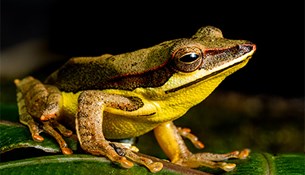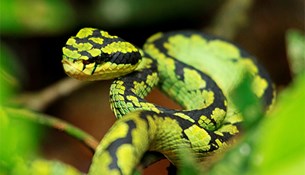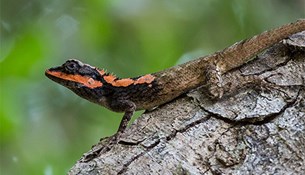Highlights
Sinharaja rainforests - prolific start to the trip
Nawalpitiya with local expert
Highlands of Horton Plains
Unique montane of Knuckles Range
Mannar dry zone scrub & coastal habitats
Wilpattu game drive for leopards & more
Introduction
We are fortunate to have a young herpetology expert among our terrific guides in Sri Lanka and he will lead you on a private tour of the best locations for discovering the wide diversity of reptiles and amphibians across Sri Lanka's key locations. If you have a specific interest, e.g. frogs or snakes, then we can alter this general herpetology holiday to your preferences.
Outline Itinerary
1. Depart UK.
2. Arrive Colombo and transfer to Sinharaja rainforest.
3. A full day exploring Sinharaja.
4. To Kitugala lowland forest.
5. Transfer to Nuwara Eliya via Nawalapitiya.
6. Excursion to Horton Plains.
7. To the Knuckles Range.
8. A full day exploring the Knuckles.
9. To Dambull area - Intermediate Zone forests.
10. To coastal Mannar - Dry Zone.
11. Explore around Mannar.
12. To Wilpattu.
13. Explore around Wilpattu.
14. Return to Negombo.
15. Depart Sri Lanka.
Cost
Please contact us for prices.
Departure Dates
Best time for travel is May - July and November - December, the wettest months which is good for amphibians.
Departure to your requirements on any date.




Description
This great value herping holiday is tailor made for you and your interests. Our itinerary here includes the best locations across Sri Lanka for finding endemic reptile and amphibian species. Frogs, lizards, geckos, skinks, and snakes abound in the variety of habitats that you will explore with your accompanying expert guide. Furthermore, should you find anything particularly unusual, your guide also has the backing of local scientific experts for further identification and verification. Time to discover!
Your journey starts by heading towards the lowland rainforests of Sinharaja located in the southwestern region of the island. During the first afternoon your time will be spent in the dense nature of this amazing ecological hotspot. After dark, the forest comes alive with the cacophony of frogs as you venture out herping in the surrounding trails bordering the forest reserve. The sheer diversity of species in this forest reserve will be sure to astound you as you traverse these trails with your naturalist guide and village trackers seeking rare endemics. Some of the most impressive and beautiful endemic frog species which you might encounter are the Sri Lanka Hollow Snouted Shrub Frog, Sri Lanka Short Horned Shrub Frog, Cheeky Shrub Frog, Orange Canthal Shrub Frog, Leaf Dwelling Shrub Frog, Long Snouted Tree Frog, Kellart's Dwarf Toad, Reticulated Thigh Shrub Frog, Sharp Snouted Shrub Frog, Schneider's Shrub Frog, Sri Lanka Petite Shrub Frog, Anthropogenic Shrub Frog among many others. If you are lucky, you will encounter one of three legless amphibians: the Ceylon caecilian and the strictly arboreal Nagao’s Pug Snout Frog which are rarities but with the hard work of your guiding team anything can be possible.
There are a number of endemic agamid lizards which can also be found mainly during the daytime hours, but also after dark while they are sleeping, which include the fascinating Sri Lanka Rough Horned Lizard and the Lyre Headed Lizard which is the largest agamid lizard species in Sri Lanka, as well as several endemic gecko species, such as the Spotted Bowfinger Gecko, Scaly Finger Gecko, Beautiful Day Gecko and the Sinharaja Bent-toed Gecko which is arboreal and rare to find. A number of endemic skinks may also be seen, from the common Sri Lanka Bronze Skink, and rarities such as Daignan's Lanka skink, Gan's Lanka skink, Taylor's Lanka skink, the Common Sun Skink, the Three-toed Snake Skink, and the Catenated Lanka skink.
The forests are also home to many serpent species, most of which are endemic to the island. The most sought after and iconic among them is the beautiful Sri Lanka Green Pit Viper, a moderately venomous pit viper, with its beautiful emerald green and yellowish coloration along with distinctive black markings. Other snake species you might find on your forays into the rainforest would be the Günther's Rough-sided Snake, Schokar's Bronzeback, Sinharaja Bronzeback, Sri Lankan Keelback, Sri Lankan Wolf Snake, Flowery Wolf Snake, Templeton's Kukri Snake, Streaked Kukri Snake, Sri Lankan Blossom Krait, Deraniyagala's Shieldtail, Lowland Hump-nosed Pit Viper, Chithrasekara’s Bridle Snake, Green Vine Snake, Olive Keelback, Barne's Cat Snake, Beddom's Cat Snake, Sri Lanka Cat Snake, Forsten's Cat Snake, Ornate Flying Snake, Sri Lanka Checkered Keelback, and Lowlands Hump-nosed Pit Viper.
As you can see, at the start of the trip, you will be fully immersed in some of Sri Lanka's endemic species and have a full day here to explore before moving on to the lowland rainforests of Kitulgala to further enhance your species list from this type of forest habitat.
After Kitulgala and before climbing to the hill station of Nuwara Eliya, you will break your journey en route with a local snake expert at Nawalpitiya, where there is the opportunity to further increase chances of finding unique snake species, including Boie's Rough-sided Snake, Black-spined Snake, Buff-striped Keelback, Russell's Viper, and Merrem's Hump-nosed Pit Viper, as well as some of those you may have missed in Sinharaja and Kitulgala.
The misty highlands around Nuwara Eliya consist of montane cloudforests and are home to many endemic species unique to this region. From a frogging perspective you can expect to find some beautiful species such as the Sri Lanka Narrow Mouthed Frog, Half-webbed Pug Snout frog, Horton Plains Shrub Frog, Asanka’s Shrub Frog, Frankenberg’s Shrub Frog, Small-eared Shrub Frog, Schmarda’s Shrub Frog, Mountain Hourglass Tree Frog as well as stunning green endemics which are a pleasure to photograph: the Leaf Nesting Shrub Frog and the Dull Green Shrub Frog. The locations for your frogging will vary greatly, your guide having in-depth knowledge as well as engaging the help of locals so that your species count is bound to increase as the days progress.
When it comes to lizards, the cold highlands are home to some very unique and bizarre looking individuals among which the iconic flagship species has to be the Sri Lanka Rhino-horned Lizard which as its name suggests sports a very impressive protrusion from its snout, as well as the small and sluggish Sri Lanka Pygmy Lizard with its prehensile tail akin to a chameleon. It is the only live bearing lizard species in Sri Lanka along with its counterpart in the Knuckles Mountains which you might encounter on your next stop. Other lizard species found in the highlands are the Sri Lanka Black Lipped Lizard as well as the Crestless Lizard.
Despite the cold weather there are two species of snakes which you might encounter, the Highland Hump-nosed Pit Viper and the Common Rough Sided Snake.
Your foray in the highlands will also include a visit to the UNESCO World Heritage Site and biodiversity hotspot, Horton Plains National Park, which is also home to many species of endemic birds as well as the rare sighting of leopards.
After exploring this highland range of habitats, you will venture once again to another unique habitat. The montane ecosystem known as the Knuckles Range is isolated from the central highlands which you earlier explored. This isolation over millions of years has created its own endemic species of reptiles and amphibians found only in this habitat and nowhere else on the island. It is a fragile ecosystem that is highly significant in respect of biodiversity of fauna and flora.
Your stay will be in the heart of the Knuckles montane forest, hence herping here would begin as soon as you reach the hotel premises. Night time forays into the wilderness is a must in order to maximize your sightings of endemics, especially the frogs which become active after dark. The species of frogs which may encounter include the Brown Pug Snout Frog, Dumbara Corrugated Frog, Sri Lanka Wood Frog, Knuckles Shrub Frog, Steiner’s Shrub Frog, as well as the beautifully green coloured Stuart’s Shrub Frog and the neon green coloured Moore’s Shrub Frog which are always a pleasure to encounter and photograph. You will also have a chance to find the moss textured Hanken’s Shrub Frog which is perfectly camouflaged to its habitat and is the Knuckles version of a sister species you would have encountered in Nuwara Eliya in the Schmarda’s Shrub Frog.
During the day, your guide will take you to Patana Grasslands to see the critically endangered Marbled Rock Frog which as its name suggests are usually found under rocks in the small streams and trickles of water flowing in these open areas. It is one of a kind species which is a must see for anyone visiting the Knuckles region.
The most iconic lizard species of this region has to be undoubtedly the Leaf-nosed Lizard, which has an unusually leaf shaped appendage from its snout which is very different to the Rhino Horned Lizard which you would have encountered earlier in Nuwara Eliya. Besides this species you will also come across other endemic lizards such as Manamendra-Arachchi's Whistling Lizard, Pethiyagoda’s Crestless Lizard, and Knuckles Pygmy Lizard, while there is also a Knuckles Bent-toed Gecko to seek out along with the Four-toed Snake Skink and Smith's Snake Skink. The unique snake species of these mountains include Desilva's Rough-sided Snake and Gunasekara's Shieldtail.
Next you descend to the lowlands of the north central region, more commonly known as the Cultural Triangle of Sri Lanka due to being the centre for many of the ancient Kingdoms and civilizations of Sri Lanka dating back over 3500 years. As an option you can choose to visit the UNESCO World Heritage Site of Sigiriya or the ancient Kingdom of Polonnaruwa if you desire. This area consists of Intermediate Zone Forests, obviously drier than the regions previously visited on this trip and home to species such as the Mihintale Narrow-mouthed Frog, Rohan's Pug Snout Frog, Marbled Balloon Frog, Jerdon's Bullfrog, Lowland Kangaroo Lizard, Four-clawed Gecko, Sri Lanka Leaf-toed Gecko, and Termite Hill Gecko; together with Dotted Garden Skink, Tammanna Skink and Brown Vine Snake, Striped Flying Snake, Trinket Snake, Bridal Snake and Green Keelback. The iconic and highly venomous species of snakes in this region include the Spectacled Cobra which has been recently categorized to be endemic and unique from its Indian counterpart, as well as the deadly Russell’s Viper which causes the highest number of deaths by snake bite in Sri Lanka and India. You may also find your first tortoise species, the Star Tortoise as well as the Soft Shelled Terrapin and the Hard Shelled Terrapin. This region also hosts the two largest lizards in Sri Lanka, the Bengal Monitor also known as the Land Monitor and the Asian Water Monitor, which is the second largest lizard species in the world.
After your brief sojourn in the North Central region of the island, you will head towards the far northwest to the coastal peninsula of Mannar. It is arid country with dry thorny scrub, mudflats, mangroves, and lagoons. This area is the best place in Sri Lanka to find the Saw Scaled Viper which as its name suggests makes a sawing sound by rubbing its scales together as it coils around continuously when in a defensive posture. The lagoons are home to the rare and elusive Dog-faced Water Snake. This region is also home to the Russell’s Viper as well as the Common Krait. Your forays in the region will include daytime as well as night time ventures to maximize on your sightings of species.
Finally, your tour concludes at Sri Lanka's largest and oldest national park, Wilpattu, which is further south along the western coast of the island and which is largely made up of dry-mixed evergreen forests. Mega fauna are the highlight here: wild elephants, sloth bears and in particular leopards. However, this dry zone still provides a chance for herping, and just outside the park there are many locations to explore cultivations and scrub for Spotted Tree Frog, Common Paddy Field Frog, Ferguson’s Toad, Sri Lankan Bull Frog and some of the other more common species you may have missed previously. Bark Gecko and Indian Chameleon may be added to your list, and another unique lizard species that can be found in this region is the endemic Painted Lipped Lizard together with Devaka’s Fan-throated Lizard.
Around Wilpattu night time excursions are not done on foot, mainly due to the risk of encountering wild elephants, but a night safari by jeep in the buffer zone can reveal some unique nocturnal mammalian species such as the Jungle Cat, Fishing Cat as well as the Grey Slender Loris.
After many days spent in a multitude of habitats and climatic zones, you can now finalise your species count as you return to Negombo for a final night before your return flight.
This is just an example of possibilities available for holidays to the island. Price is dependant on season, style of accommodation and length of stay. Please contact us for further details or to create your tailor made your holiday.